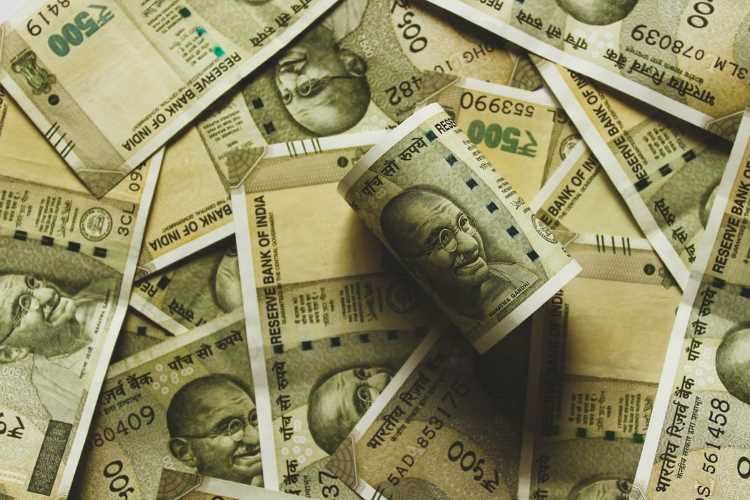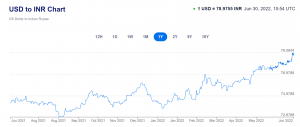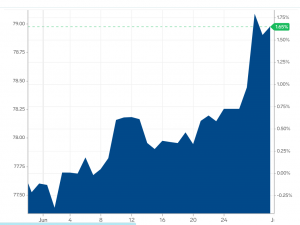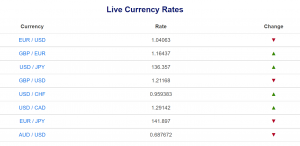
The rupee touched a historic low of 79.04 against the dollar on Wednesday. The slide of the domestic currency has several internal and external reasons such as global inflation, rising interest rates in the US, and plunging markets, leading to the flight of foreign capital from the economy. The weak rupee could snowball into a full-blown crisis for the Indian economy which is already facing the headwinds of inflation.
The biggest impact of the weak currency will be felt in fuel prices as India imports more than 80% of its energy requirements. The currency is expected to remain under pressure in the near future, considering Fed Chair Jerome Powell’s statement that high interest rates in the US will further slow down the world’s largest economy. The rupee has crashed 6.39% against the dollar since the beginning of 2022.
What’s causing the rupee fall?
Since the time Russia invaded Ukraine in February, the rupee has been on a downward journey along with the currencies of other emerging markets. The rupee has been trading at all-time low levels, owing to a rise in the dollar index and concerns around global economic growth. On the other hand, the dollar index has hit a nearly two decade high, taking cues from the weak economic data around the world, especially from China.
READ ALSO| GST Council recommends rate hikes on some items, relief on others
The flight of funds as investors move to high-yielding financial instruments abroad exerts pressure on the rupee. The rupee’s cause is further weakened by the skyrocketing import costs and a growing current account deficit. India’s merchandise trade deficit widened to $20.1 billion in April. Moreover, brent crude oil prices have jumped to 14-year highs as the conflict between Russia and Ukraine lingers.
Is the rupee’s fall unprecedented?
Historically, the rupee has always been in a precarious position and weakens on any cue of global disruption. Take for example the Global Financial Crisis of 2008 which led to a fall or the recent coronavirus pandemic that forced most global investors and businesses to seek a safe haven in stable assets such as gold and the dollar. In 2008, the dollar gained about 22% against the Euro as enterprises, especially in the world’s largest economy, hoarded the American currency.



For the rupee, the start of March 2020 wasn’t pleasant as overseas investors dumped Indian equities and debt on a scale not seen since the taper tantrum of 2013. The fall was even more worrisome considering the month of March usually serves well for the Indian rupee as remittances, from both individuals and companies tend to buoy the exchange rate.
How does the rupee’s fall affect you?
To the common man, the fall of the rupee translates into a rise in inflation as the weak currency keeps import bills higher. Simply put, brace for higher fuel prices as India is heavily dependent on foreign supplies for its energy requirements. A weak rupee is detrimental to import-oriented industries such as oil, gas and chemicals, as well as companies that operate franchises of foreign companies in India.
Auto, real estate, and infrastructure sectors are also likely to suffer. For those who look to travel abroad or students pursuing higher studies in foreign nations, a weaker rupee means shelling out more to buy dollars from banks. All in all, travel will be costlier, and so will be foreign studies.
Will the rupee fall further?
Before the rupee slipped to a historic low on Wednesday, experts were already predicting a fall up to Rs 81 against the dollar. In fact, it is expected that the coming five to six months will cause more pressure on the Indian currency. This is despite the government’s efforts to check the fall. In May, the central bank had used its stockpile of forex reserves to prevent further depreciation of the domestic currency. That inflation is on an upward trend is no relief either and will put further pressure on the currency.
The RBI may allow the rupee to slip further, but will intervene to curb volatility in the currency market. The central bank sells dollars when the currency depreciates too fast for its comfort. The country’s forex reserves have slipped from $632.74 billion in January to $590.59 billion after the RBI sold close to $30 billion during March-April period to stem the rupee fall.
Prachi Gupta is an Assistant Editor with Policy Circle. She is a post graduate in English Literature from Lady Shri Ram College For Women, Delhi University. Prachi started her career as a correspondent with financialexpress.com. She specialises in policy impact studies.

